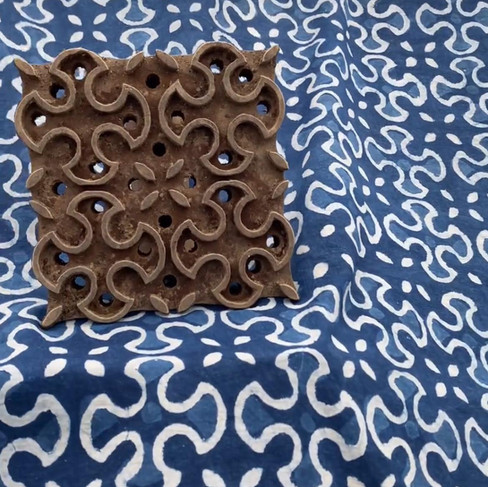Block printing is a traditional method of printing patterns on textiles using carved wooden blocks. This ancient technique involves dipping the blocks into dye and stamping them onto fabric, creating intricate and repetitive designs. Each block is meticulously hand-carved with motifs, ranging from floral patterns to geometric shapes, making every print unique.
TABLE OF CONTENT:
History of Block Printing
The origins of block printing in India date back to at least the 12th century. The technique likely originated in China and made its way to India through trade routes. Over the centuries, Indian artisans perfected the craft, and it flourished in regions like Gujarat, Rajasthan, and Madhya Pradesh. The Mughal era marked a significant period of growth for block printing, as it received royal patronage and became an integral part of textile production.
Types of Block Printing
Sanganeri Prints: This type of hand block printing technique is practised in the Sanganeri district of Rajasthan. Primarily, red and yellow colours are used for this kind of block printing and the motifs/designs are usually inspired by nature. Moreover, the dyes used in Sanganeri block printing are natural dyes.
Bagru Prints: Bagru block printing is a special kind of block-printed fabric that is done using a ‘Chippa’ and natural colours. The design is engraved on the wooden block and then engraved on the fabric.
Ajrakh Prints: Found in Gujarat and Rajasthan, Ajrakh printing relies on the use of natural vegetable dyes. It is characterized by crimson red and indigo hues as the background on the printed cloth.
Dabu Printing: This resist-dyeing technique from Rajasthan involves using mud to create patterns before dyeing the fabric, resulting in unique prints. This form of printing is a rather cumbersome process and the fabric is made to go through various phases of washing, printing, mud resistance and then drying.
Kalamkari: Although primarily known for its pen work, Kalamkari also includes block printing in Andhra Pradesh and Tamil Nadu, often depicting mythological themes. For Kalamkari, the fabric is stiffened and dried. After that, different prints are carried out as per the design. Wax is used for dyeing blue colour whereas all other colours are hand-painted.
Bagh Printing: Bagh a small town in Madhya Pradesh India is the origin of this kind of Block printing. For Bagh's painting, geometric designs are made with bright colours. For this printing process, the fabric undergoes a ‘Bhatti process’ that entails boiling, drying and subsequent printing. The chemical properties of the local river Bagh, enhance the unique shades and make them prominent.

Cultural Significance
Block printing is deeply embedded in India's cultural fabric. It is not just a craft but a way of life for many artisan communities. The motifs and designs often carry symbolic meanings, representing local flora, fauna, and cultural narratives. Block printed textiles are used in various traditional garments, home decor, and even in religious contexts.
Block Printing in Modern Times
In contemporary India, block printing has seen a revival, blending traditional techniques with modern aesthetics. Designers and fashion houses are incorporating block printed fabrics into their collections, making it popular both domestically and internationally. The slow fashion movement has also contributed to the resurgence of block printing, as consumers increasingly seek sustainable and handcrafted products.
Challenges
Despite its cultural and economic significance, block printing faces several challenges:
Competition from Machine Printing: Mass-produced textiles often overshadow handcrafted block prints, making it difficult for artisans to compete on price.
Economic Pressures: Artisans often struggle with low wages and lack of access to markets, affecting their livelihood and the craft's sustainability.
Environmental Concerns: Traditional block printing uses natural dyes, but some modern practices involve chemical dyes, posing environmental risks.
Role of Geography in the Uniqueness of Regional Block Printing
Geography plays a crucial role in the distinctiveness of block printing styles across India. The natural resources available in each region, such as specific types of wood for blocks and local plants for dyes, influence the characteristics of the prints. For example, the arid climate of Rajasthan supports the production of vivid, fast-drying colors used in Bagru and Sanganeri prints, while the mineral-rich waters of the Kutch region contribute to the unique shades of Ajrakh prints.
GI Tagging Status
Geographical Indication (GI) tags are used to protect the unique identity of regional crafts. Several block printing styles in India have received GI tags, including:
Sanganeri Hand Block Printing: Recognized for its fine detailing and vibrant colors.
Bagru Hand Block Print: Known for its traditional and natural dye techniques.
Ajrakh Block Print: Celebrated for its complex patterns and natural dyeing process.
These GI tags help preserve the heritage of block printing and ensure that the artisans receive due recognition and economic benefits.
Experiencing Block printing through Craftique Hub
Discover the intricate world of block printing with Craftique Hub's exclusive 'Jaipur Traditional Craft Tour' where you can experience the beauty of Bagru Mud Printing at sreeji Hasthkala's workshop in Bagru. To explore the traditional Bagh and Batik Printing of Madhya Pradesh check out 'Heritage Textile Trail of Madhya Pradesh'. These tours offer an immersive experience, allowing you to delve into the detailed process of block printing and witness the craftsmanship firsthand.
Conclusion
Block printing in India is a testament to the country's rich artistic heritage. Despite modern challenges, it continues to thrive, adapting to contemporary tastes while preserving traditional methods. As consumers and designers increasingly value sustainability and craftsmanship, block printing is poised to remain a significant and cherished art form for generations to come.












Comentários